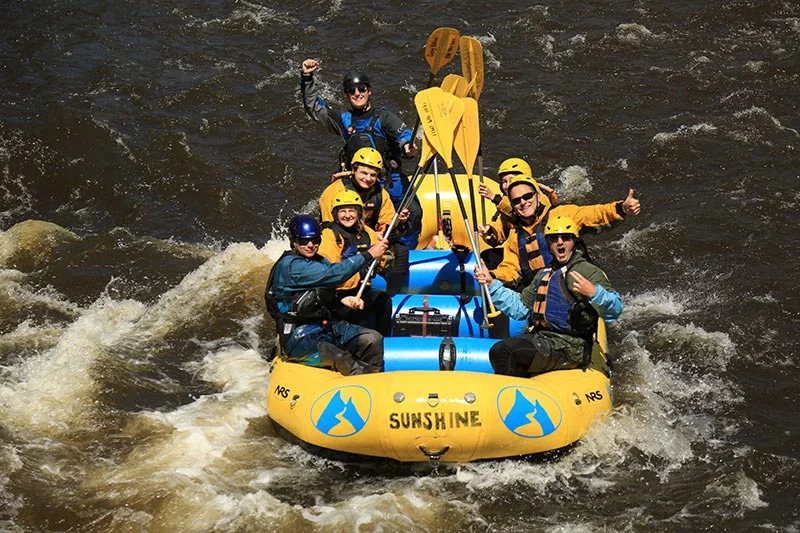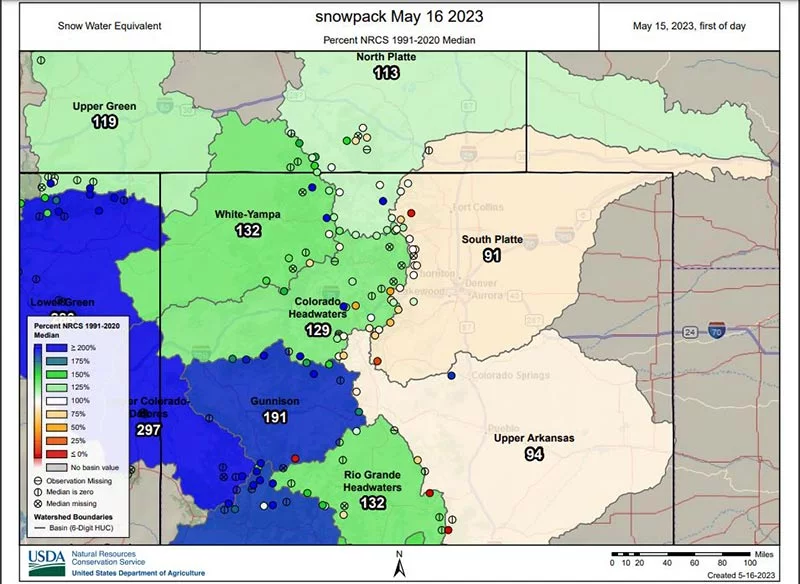
Heavy winter snow made for an epic ski season. As all that snow melts, river enthusiasts hope for an equally stellar whitewater rafting season this summer in Colorado.
Whitewater rafting in Colorado
The Rocky Mountains in Colorado provide some of the most exciting river adventures in the country. Rivers flow through diverse terrain, from narrow gorges and towering canyon walls to dense pine forests and lush farmland, giving rafters options that range from relaxing to heart-stopping.
“A rafting trip will be the highlight of your summer for sure,” said Brad Modesitt, who owns Mountain Whitewater with his wife, Lindsey, and offers guided trips on the Cache la Poudre northwest of Fort Collins, Colorado.

For many commercial rafting companies, the season begins with the snowmelt (called runoff) — which has already started to flow, so rafting trips are kicking off. For the past two seasons, rafting companies have seen dryer winter and spring conditions, which affects what rivers they’re able to run and the length of the season.
“No year is like any other year, but that’s what makes my life interesting and fun,” Modesitt said. “This year, the snowpack is at a good level, and this should be a good, fun season.”
How will this year’s ‘big water’ affect the difficulty of a rafting trip?
Colorado is seeing above-normal snowpack across much of the state – as much as 200% of normal in Western Colorado – which peaked on April 8, according to the USDA Natural Resources Conservation Service.

A big snowpack year usually means ‘big water’ and an extended rafting season for river runners. But many environmental factors, such as temperatures, rate of snow melt and precipitation, influence how and when runoff comes down through the recreational areas of rivers. Local rafting companies will be your best source of information about river conditions in their area.
NRCS hydrologist Karl Wetlaufer warns residents of the Upper Colorado River Basin (Colorado waterways that eventually run into Lake Powell) that there are still several months of snowmelt runoff ahead.
“While plentiful streamflow is certainly good news from a strictly water-supply standpoint … it is important for everyone in Colorado to be mindful of flood potential and those associated hazards,” Wetlaufer said in a press release.
Given variable conditions on Colorado waterways, he warned rafters to pay close attention to weather forecasts and changing conditions.
“People get excited about big water, big snowpack and big rapids,” said Jaci Dvorak, who has owned and operated Dvorak Expeditions along the Arkansas River with her husband, Bill, since 1979. “We want to bring people on these rivers and show them that excitement, but we choose both rivers and guides carefully.”
How do experts measure water flow, and how does flow affect rafting options? Should I check a river’s flow before going rafting?
The U.S. Geological Survey (USGS) measures streamflow in cubic feet per second (cfs) and measures stream stage, also called stage or gage height, in feet.
The stream stage is the height of the water surface at a specific location within the river. The stream flow is how much water is passing through that particular location in one second (think, how many soccer balls could pass through that spot in one second — that’s the river’s cfs in that location).
The “specific location” is called a gaging station. You can find the data for that station – current and historical – on the USGS website. Rafting companies are also a great resource for this information. They pay close attention to river flows and know what happens on their rivers at certain water levels.

Are there more options for rafting this year because there is more water?
Alex Mickel, founder and president of Mild 2 Wild Rafting of Durango, Colorado, said he has experienced every type of rafting season possible since he founded the company in 1994.

This year, he is excited that his area’s 200% of average snowpack means that a few river “jewels” are now accessible to rafting. The Dolores River included.
“The Dolores is always a special treat,” he said. “We only get to run that about three out of every 10 years on average.”
Dvorak is expecting an epic year with greater access to unusual routes.
“The Dolores is a real bonus,” she said, adding that more seasonal rivers like the North Platte River near Encampment, Wyoming, and the San Miguel River, which runs out of Telluride, Colorado, should also have extended seasons this year.
For Thomas Carder, owner of Whitewater Rafting, LLC. in Glenwood Springs, Colorado, his “bonus” river is the Roaring Fork that runs through Aspen and into Glenwood Springs, where it meets the Colorado River.
“We are always able to run the Roaring Fork, but it’s more fun and exciting for our guests at high water,” he said.
He is currently offering trips on the Colorado River in the Glenwood Springs area.
“Our season is fantastic so far with multiple options with multiple sections,” he said. “Colorado (River) offers some fun class III’s and way more river miles than years past.”
In the Poudre Canyon, companies started offering trips in mid-May, and Modesitt is pleased with what winter left.
“We are right at average (snowpack), and that’s exactly what we want,” Modesitt said. “That means we will have nice high water in June, and July will be a medium level, leading us through August.”

When is the best time to go rafting in Colorado?
Colorado rivers are going into runoff season as the Memorial Day weekend gets underway. However, how long runoff will last depends on environmental factors, including temperatures, rate of snow melt and precipitation. And those factors will differ by region and by river.
The earlier season often means colder and swifter water. Later in the season means slower and slightly warmer water and warmer overall temperatures. Check with the rafting company for more information.
How to pick your next Colorado whitewater rafting adventure?
No matter where you find yourself in Colorado, a rafting adventure awaits not far away.
As many as 190 river outfitters hold state-required licenses allowing them to provide river-running services commercially in the state. To obtain a permit, companies must pass safety inspections, meet guide qualification standards, and follow other strict rules and regulations set by Colorado Parks and Wildlife.
Some rivers can only offer a few-hour rafting adventure because of location and the type of river. These trips are fun and provide a lasting memory to share with family and friends.
“Anytime you can hang out with friends and then reminisce afterward is a great time,” said Modesitt, whose Mountain Whitewater property includes Paddler’s Pub, a large outdoor, family-friendly area that customers can enjoy after their trip. The venue is also open to the public.
Some companies can offer multi-day trips, providing everything you need from your meals (and I promise, it will be some of the best camping food you’ve ever had) to all your equipment. It is a vacation unlike any other, Dvorak said.
“Our goal is to get people back into multi-day trips because those are the ones that have the biggest impact on people’s lives,” she said. “Driving three hours for a few-hour trip and then having to drive back home three hours is not the experience we want people to have, and that’s why one might want to consider a multi-day trip.”
Because there are so many options for Colorado rivers, there is something for every age and ability. Discuss this with the company when you book your trip. And let them know if anyone in your party has physical limitations or a medical condition.

How are rapids classified? Which is best for me?
Rapids are rated using the International Scale of River Difficulty, which ranks rapids from Class I (least difficult) to Class V (most difficult). The higher the class, the more elements of the river and the more skill needed to navigate those elements. Class I rapids usually feature small waves and pose low risk. A Class IV rapid can be long and challenging in turbulent water. Guides at this level need to maneuver through complex obstacles.
Not only the features of the river determine the class of rapid, but also the river flow (cfs.) Rapids can become larger through a narrow channel at higher water, or “holes” may form or disappear behind large rocks in the river depending on flow, increasing or decreasing that rapids classification.
Colorado rivers offer people various choices regarding rapids, from a family float that might provide a few face splashes to an adrenalin-packed, hard-paddling adventure that leaves you soaked.
“Make sure to check with the outfitters and listen to their experiencing,” Dvorak said.
Making a reservation vs. walk-in for whitewater rafting in Colorado
All rafting companies will try to accommodate your trip preference last minute. Still, if you have time, plan to have a large group or are venturing out during a holiday, it is best to call and book your rafting trip a few weeks before you want to go – once your plans are certain.
“My favorite thing about rafting is being outside and forgetting about the rest of the things going on in the world and my personal life – even if just for a little bit,” Carter said. “Rafting allows you to focus on being alive.”
